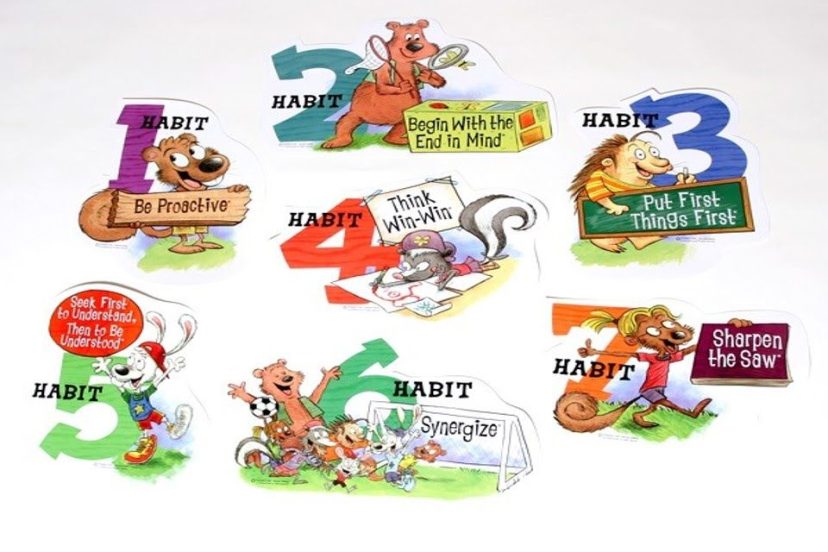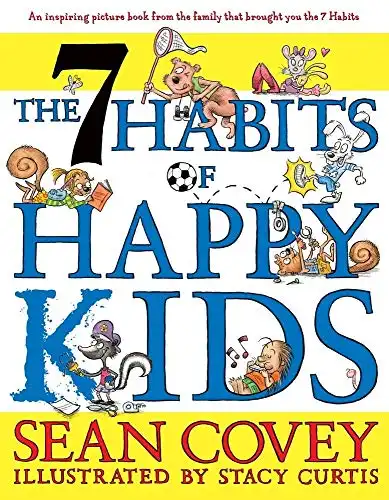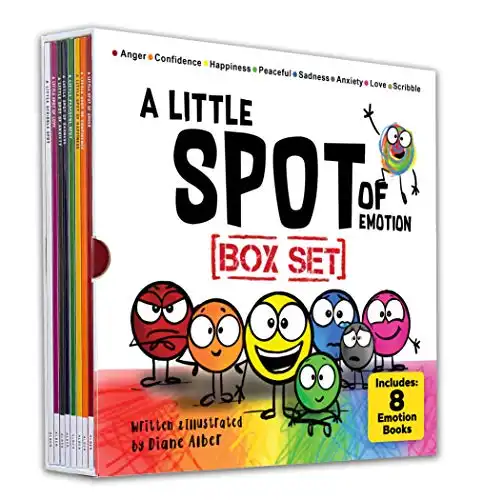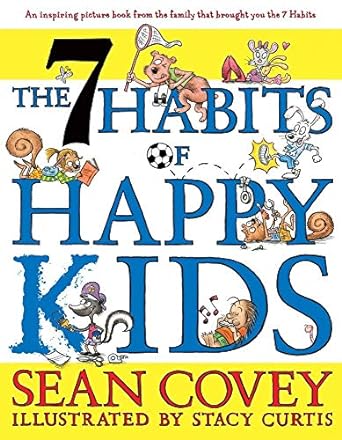The 7 Habits of Happy Kids By Sean Covey: A Thorough Guide for Parents
If you’re anything like me, then you’re probably constantly searching for tools to help your kiddo shine brightly in this chaotic world. A while back, I stumbled upon a gem – Sean Covey’s “The 7 Habits of Happy Kids.” And let me tell you, it was an enlightening read! It wasn’t just the captivating illustrations that got me; it was the deep yet simple wisdom embedded in its pages. The stories, the lessons, oh my!
The overarching theme of “The 7 Habits of Happy Kids” is personal responsibility and effective interpersonal skills. The habits guide children to become proactive, goal-oriented individuals who can work well with others and continuously seek personal growth.
For the Seven Oaks friends, there is always something to do. Whether they're singing along with Pokey Porcupine's harmonica or playing soccer with Jumper Rabbit, everyone is having fun and learning all sorts of things. These seven stories show how practicing the 7 Habits makes this possible for the whole Seven Oaks Community.
They emphasize the importance of taking charge of one’s own actions and reactions, setting and achieving goals, prioritizing tasks, seeking mutual benefits in interactions, listening before speaking, collaborating effectively, and taking time for self-renewal.
Delving into the 7 Habits Of Happy Kids
Habit 1: Be Proactive – Taking Control of Your Actions and Emotions
What does it mean to be proactive? At its core, being proactive is about taking responsibility for our behavior, actions, and emotions. Instead of reacting to external events, proactive individuals recognize that they have a choice in how they respond.
Understanding Reactivity vs. Proactivity:
Reactivity: Reactive individuals are often influenced by external events. They might blame others for their feelings or behaviors, often using language like “I can’t” or “I have to.”
Example: Imagine a kid saying, “I couldn’t do my homework because my little brother kept distracting me.”
Proactivity: In contrast, proactive individuals believe they can control their reactions to external events. They use responsible language, such as “I can” or “I choose to.”
Example: The same kid, if proactive, might say, “I chose to finish my homework in another room when my little brother was being noisy.”
The Circle of Influence vs. The Circle of Concern:
Sean Covey introduces two concentric circles:
- Circle of Concern: This includes all the things we might worry about, from the weather to world news. Most of these are beyond our immediate control.
- Circle of Influence: Within the larger Circle of Concern lies this smaller circle, which includes things we can directly influence and control.
Proactive individuals focus their energy on the Circle of Influence, recognizing that by doing so, this circle expands. On the other hand, reactive individuals focus on the Circle of Concern, which can lead to feelings of powerlessness.
Tools to Foster Proactivity in Kids:
- Choice and Control: Teach kids they always have a choice. For instance, they can’t control if it rains on the day of their outdoor party, but they can choose to have fun indoors.
- Language: Encourage the use of proactive language. Instead of “I have to,” promote “I choose to” or “I can.”
- Role-Playing: Through role-playing scenarios, kids can practice proactive responses to common challenges.
- Sharing Stories: Share stories of individuals who’ve shown proactivity in challenging situations. These could be from real life, books, or movies.
- Celebrate Small Wins: Recognize and praise moments when your child shows proactivity. This reinforces the behavior.
Habit 2: Begin With the End in Mind – Setting a Clear Direction
What’s the essence of this habit? Simply put, “Begin With the End in Mind” emphasizes the importance of setting clear goals and having a vision for the future. It’s about understanding where you want to go, so you can take the necessary steps to get there.
The Power of Vision:
Imagine setting off on a journey without a clear destination. Chances are, you’d wander aimlessly. Similarly, when kids lack a clear purpose or goal, their efforts may be scattered. Having a vision provides direction, motivation, and a sense of purpose.
Crafting Personal Mission Statements:
One of the practical applications of this habit is creating a personal mission statement. Even for kids, a simple statement about what they want to be or achieve can act as a guiding star.
For instance, a child’s mission statement could be as straightforward as, “I want to be kind and help others.”
Setting Small Goals to Achieve Bigger Dreams:
While the end goal is essential, it’s equally important to break it down into manageable steps. Kids can benefit from setting smaller, achievable goals that lead them closer to their larger vision.
For instance, if a child’s vision is to become a great pianist, a smaller goal could be to practice for 15 minutes every day.
For the Seven Oaks friends, there is always something to do. Whether they're singing along with Pokey Porcupine's harmonica or playing soccer with Jumper Rabbit, everyone is having fun and learning all sorts of things. These seven stories show how practicing the 7 Habits makes this possible for the whole Seven Oaks Community.
Visualization Techniques:
Visualizing the end goal can be a powerful motivator. Encouraging kids to picture their success, whether it’s visualizing themselves acing a test or scoring a goal, can provide motivation and clarity.
Tools to Foster the Habit in Kids:
- Dream Boards: A dream board filled with pictures and words representing their goals can be a visual reminder for kids.
- Journaling: Writing down goals and reflecting on them can solidify a child’s commitment.
- Discussions: Regularly talk about goals and aspirations. Asking questions like “What do you want to achieve?” or “How do you want to feel?” can guide them.
- Role Models: Share stories of individuals who had a clear vision and achieved their dreams. It can be historical figures, characters from stories, or even personal anecdotes.
- Celebrate Achievements: Recognizing milestones, no matter how small, reinforces the importance of setting and working towards goals.
Habit 3: Put First Things First – Prioritizing What Truly Matters
So what’s at the heart of this habit? “Put First Things First” is about managing your time and priorities effectively. It’s understanding that not everything that demands your attention is important, and it’s essential to focus on tasks and activities that align with your values and long-term goals.
The Concept of Urgent vs. Important:
Many of us tend to be consumed by the “urgent” tasks in life, whether it’s responding to a barrage of emails or attending last-minute meetings. However, not all urgent tasks are important.
For kids, an urgent task might be playing a trending video game because all their friends are, whereas an important task might be completing a school project or helping with chores.
The Time Management Matrix:
Covey introduces a time management matrix, divided into four quadrants, to help prioritize tasks:
- Quadrant I (Urgent and Important): These are critical tasks that need immediate attention, like finishing a school assignment due the next day.
- Quadrant II (Not Urgent but Important): These tasks are crucial for long-term success but aren’t time-sensitive, like regular study habits or building meaningful relationships.
- Quadrant III (Urgent but Not Important): These are the distractions in life. They seem pressing but don’t align with long-term goals, like some social events or certain notifications on phones.
- Quadrant IV (Not Urgent and Not Important): These are activities that are neither pressing nor align with long-term aspirations, like mindlessly watching TV or aimless web surfing.
To be effective, one should spend more time in Quadrant II, focusing on activities that might not seem urgent but are undoubtedly important in the long run.
Strategies to Help Kids Embrace the Habit:
- List Making: Encourage kids to make a daily list of tasks and categorize them based on their urgency and importance.
- Role Playing: Create scenarios and let your child decide which tasks are urgent, which are important, and how they’d prioritize them.
- Setting Boundaries: Help kids set specific times for activities, such as homework, play, and chores, emphasizing the importance of completing essential tasks before indulging in leisure.
- Discussing Consequences: Talk about the potential outcomes of not putting first things first. For instance, the consequence of not studying could be poor grades.
- Practice Delegation: Teach them that it’s okay to ask for help or delegate tasks when needed, emphasizing the value of teamwork.
Habit 4: Think Win-Win – Cultivating a Mutual Benefit Mindset
What exactly does “Think Win-Win” mean? At its heart, this habit emphasizes the idea of seeking mutual benefit in all interactions and situations. Instead of thinking competitively (Win-Lose) or like a martyr (Lose-Win), it’s about striving for solutions where everyone can benefit, creating a harmonious and cooperative environment.
The Various Mindsets:
- Win-Lose: This is the competitive paradigm. It’s the belief that for one to win, another must lose. In kids, this might manifest in attitudes like bragging or putting others down to appear superior.
- Lose-Win: This is the martyrdom attitude. People with this mindset often give in too quickly, seeking harmony but at the expense of their own needs or desires. A child with this attitude might always let others choose the game, even if they never enjoy it.
- Lose-Lose: This is a result of vindictive or spiteful thinking. It’s the mindset of “If I can’t have it, neither can you.” For example, a kid who breaks a toy so that if they can’t play with it, no one can.
- Win-Win: This is the attitude of mutual benefit. It’s about believing that it’s possible for everyone to win. A child embracing this might suggest a game that everyone likes or finds a way to share toys so that everyone is happy.
Why is Win-Win Important?
- Builds Strong Relationships: When everyone feels they’re benefiting, relationships are strengthened. It reduces the chances of resentment or feelings of being taken advantage of.
- Promotes Creativity: Finding solutions that benefit everyone often requires out-of-the-box thinking, fostering creativity and innovation.
- Encourages Cooperation: In a Win-Win environment, people work with each other rather than against each other, leading to a more cooperative and harmonious community.
Cultivating a Win-Win Mindset in Kids:
- Role Modeling: Children often mimic adult behavior. By consistently demonstrating a Win-Win attitude in your interactions, kids are more likely to adopt it.
- Open Discussions: Talk to kids about the different mindsets and the consequences of each. Discuss real-life situations and hypothetical scenarios, asking them how they might approach them with a Win-Win attitude.
- Celebrating Collaborative Efforts: Highlight and praise instances where kids have collaborated well together, showing them the tangible benefits of mutual success.
- Teaching Empathy: For a child to want mutual wins, they need to understand and care about the feelings of others. Activities and discussions that foster empathy can be instrumental in cultivating a Win-Win attitude.
- Conflict Resolution: When conflicts arise, guide children in finding solutions that satisfy all parties involved. Over time, this can train them to naturally seek mutually beneficial solutions.
Habit 5: Seek First to Understand, Then to Be Understood – Mastering the Art of Listening
What does this habit entail? “Seek First to Understand, Then to Be Understood” stresses the significance of listening empathetically to truly understand a person before expressing your viewpoint. It’s recognizing the value of perspective and placing genuine understanding above immediate response.
The Power of Empathetic Listening:
Empathetic listening goes beyond just hearing words. It involves understanding and feeling the emotions, motives, and thoughts of the speaker. It’s about getting into their shoes and viewing the world from their lens.
Why Is This Habit Essential?
- Builds Trust: When people feel genuinely understood, it fosters trust, making interactions more open and constructive.
- Reduces Conflict: By understanding the root of a person’s feelings or viewpoint, conflicts can be addressed more effectively and often prevented altogether.
- Enhances Learning: Listening actively and empathetically can lead to deeper insights and broader perspectives.
Common Barriers to Effective Listening:
- Immediate Response: Many of us listen with the intention to reply, not to understand. We’re formulating our response even before the other person has finished speaking.
- Judgment: Entering a conversation with preconceived notions or judgments can hinder genuine understanding.
- Distractions: In our digital age, distractions are everywhere. True listening requires undivided attention.
Ways to Cultivate This Habit in Kids:
- Active Listening Exercises: Encourage activities where kids repeat back what they’ve heard, ensuring they’ve truly grasped the message.
- Role Modeling: Demonstrate empathetic listening in your interactions with them and others.
- Emotion Identification: Discuss various emotions with kids, helping them recognize and label feelings. This can enhance their ability to understand emotions in others.
- Scenario Discussions: Present hypothetical situations and discuss different perspectives, emphasizing the importance of understanding each viewpoint.
- Feedback: After conversations, discuss what was understood and what might have been misinterpreted, teaching them the importance of clarification.
A little spot was developed with children, parents and teachers in mind. These books have been carefully crafted to make not only teaching SEL fun learning it too!
The Second Part: Then to Be Understood
Once we genuinely understand, it’s equally important to express ourselves clearly and assertively. This isn’t about dominating a conversation but presenting our viewpoints in a manner that’s receptive to others.
Strategies for Effective Expression:
- I Statements: Teach kids to use statements like “I feel” or “I believe,” which convey feelings without assigning blame.
- Storytelling: Sharing personal experiences can be a powerful way to express oneself, providing context and relatability.
- Practice: Role-play with kids, allowing them to practice both listening and expressing in various scenarios.
Habit 6: Synergize – Harnessing Collective Genius
Introduction to the Habit:
What is at the heart of “Synergize”? This habit focuses on collaborative teamwork, celebrating differences, and leveraging individual strengths for a collective goal. It’s the understanding that the whole is greater than the sum of its parts, and by working together, we can achieve outcomes unimaginable when working alone.
The Power of Synergy:
- Diverse Perspectives: Synergy allows for varied viewpoints, leading to comprehensive solutions.
- Optimized Strengths: Every individual brings a unique strength to the table. By synergizing, these strengths are optimized, and weaknesses mitigated.
- Efficiency: Team efforts often lead to faster and more efficient solutions to problems.
Why is Synergizing Important?
- Encourages Open-mindedness: Collaborating fosters an understanding and appreciation for diverse perspectives.
- Boosts Creativity: Different viewpoints often lead to out-of-the-box solutions and creative ideas.
- Fosters Interpersonal Skills: Working in teams enhances communication skills, empathy, and conflict resolution abilities.
Barriers to Effective Synergy:
- Ego: Thinking one’s ideas are superior can be a roadblock to true collaboration.
- Lack of Trust: For synergy to occur, there needs to be mutual trust among team members.
- Poor Communication: Misunderstandings or lack of clarity can hinder synergistic efforts.
Ways to Cultivate the Habit of Synergizing in Kids:
- Team Activities: Encourage group projects, team sports, or collaborative games that require collective input and strategy.
- Celebrate Differences: Discuss the strengths of each family member and how they contribute to the household, emphasizing the value of individual strengths.
- Role-playing: Create scenarios where kids need to collaborate to find solutions, allowing them to practice communication and compromise.
- Feedback: After group activities, discuss the dynamics, what went well, and where they could improve in terms of collaboration.
Parental Strategies to Reinforce Synergy:
- Family Projects: Undertake projects where everyone has a role, like gardening or DIY crafts.
- Open Conversations: Encourage dialogues about the value of teamwork and instances where family members felt the positive impact of synergy.
- Highlight Real-life Examples: Discuss stories or events where teamwork led to success, reinforcing the concept.
Habit 7: Sharpen the Saw – Nurturing the Body, Mind, and Soul
What does “Sharpen the Saw” imply? The essence of this habit lies in the idea of self-renewal and self-care. It’s a metaphor for maintaining your greatest asset – yourself. Just as a carpenter needs to periodically sharpen their saw to keep it effective, we need to rejuvenate ourselves regularly to stay balanced and efficient.
The Four Dimensions of Renewal:
- Physical: This refers to maintaining a healthy body through regular outdoor exercise, a balanced diet, and sufficient rest.
- Mental: This encompasses continuous learning, reading, writing, and teaching. It’s about keeping our minds active and challenged.
- Emotional/Social: This involves building meaningful relationships, understanding emotions, and effectively managing them.
- Spiritual: This refers to our core values, inner belief system, and connection to a larger purpose or understanding.
Why is Sharpening the Saw Important?
- Boosts Productivity: Just like a sharp saw cuts better, a well-rested and balanced individual performs tasks more efficiently.
- Enhances Well-being: Regular self-renewal leads to a more balanced life, reducing stress and elevating overall well-being.
- Fosters Continuous Growth: It instills a habit of lifelong learning and adaptation, ensuring personal growth.
Practical Ways for Kids to Embrace this Habit:
- Physical Activities: Encourage sports, dancing, walking, or any form of exercise that the child enjoys.
- Mental Challenges: Introduce them to puzzles, reading, arts, or musical instruments. Discuss what they learn and encourage curiosity.
- Social Connections: Foster friendships, family time, and team activities. Teach them empathy, active listening, and effective communication.
- Spiritual Anchoring: This doesn’t necessarily mean religion. It could be nature walks, meditation, or discussions about life, purpose, and the universe.
Strategies for Parents to Reinforce this Habit:
- Set a Routine: Have specific times for relaxation, hobbies, and self-care activities.
- Role Model: Children often emulate what they see. Make sure they see you practicing self-care and self-renewal.
- Limit Screen Time: While technology is beneficial, excessive screen time can be detrimental. Set limits and encourage other forms of rejuvenation.
- Family Activities: Plan family outings or activities that emphasize physical, mental, emotional, or spiritual renewal.
Closing Thoughts From Me
The “7 Habits of Happy Kids” by Sean Covey offers invaluable insights into nurturing well-rounded, resilient, and empathetic children. These habits, ranging from personal responsibility to effective teamwork, lay the foundation for a fulfilling, balanced life.
By instilling these principles early on, we empower our kids to navigate the complexities of life with confidence, compassion, and a deep sense of purpose.
FAQs
Is The 7 Habits of Happy Kids suitable for all age groups? Absolutely! While it’s primarily designed for kids, its lessons are timeless and ageless.
How can I make The 7 Habits of Happy Kids a daily practice? Consistency is key. Perhaps a daily reflection or discussion can help reinforce them.
What if my child finds a particular habit challenging? It’s okay. We all have our strengths and areas of growth. Patience and encouragement can do wonders.
How can schools incorporate these habits? Schools can integrate them into curriculums, storytelling sessions, or even daily reflections.
Are there any additional resources to deepen our understanding? Yes! Sean Covey has various tools and activity books complementing his main book. Dive in!







